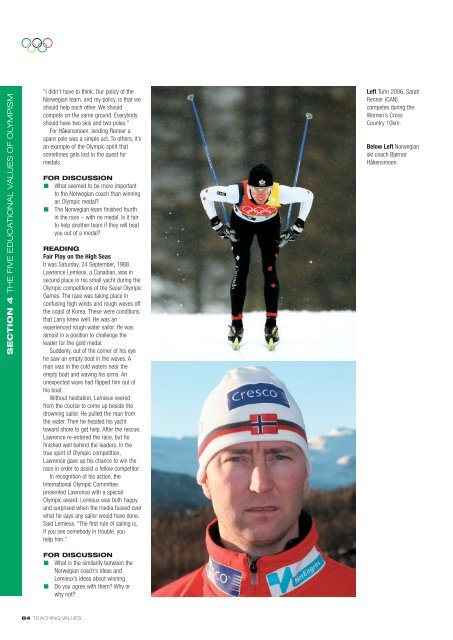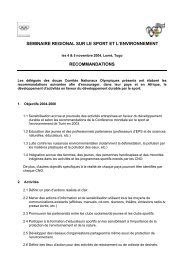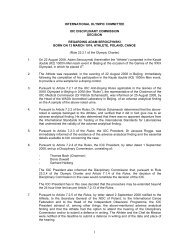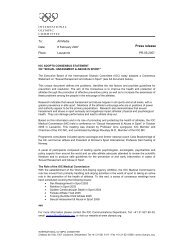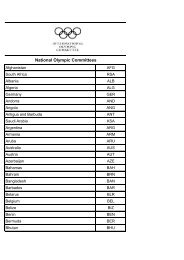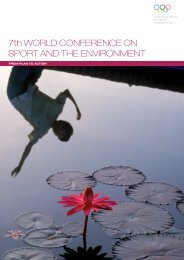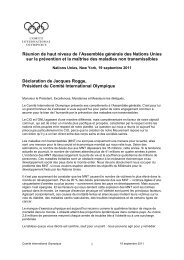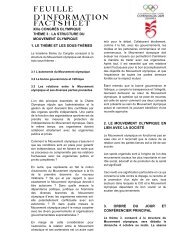Teaching Values- An Olympic Education Toolkit - International ...
Teaching Values- An Olympic Education Toolkit - International ...
Teaching Values- An Olympic Education Toolkit - International ...
You also want an ePaper? Increase the reach of your titles
YUMPU automatically turns print PDFs into web optimized ePapers that Google loves.
SECTION 4 THE FIVE EDUCATIONAL VALUES OF OLYMPISM<br />
“I didn’t have to think. Our policy of the<br />
Norwegian team, and my policy, is that we<br />
should help each other. We should<br />
compete on the same ground. Everybody<br />
should have two skis and two poles.”<br />
For Håkensmoen, lending Renner a<br />
spare pole was a simple act. To others, it’s<br />
an example of the <strong>Olympic</strong> spirit that<br />
sometimes gets lost in the quest for<br />
medals.<br />
FOR DISCUSSION<br />
What seemed to be more important<br />
to the Norwegian coach than winning<br />
an <strong>Olympic</strong> medal?<br />
The Norwegian team finished fourth<br />
in the race – with no medal. Is it fair<br />
to help another team if they will beat<br />
you out of a medal?<br />
READING<br />
Fair Play on the High Seas<br />
It was Saturday, 24 September, 1988.<br />
Lawrence Lemieux, a Canadian, was in<br />
second place in his small yacht during the<br />
<strong>Olympic</strong> competitions of the Seoul <strong>Olympic</strong><br />
Games. The race was taking place in<br />
confusing high winds and rough waves off<br />
the coast of Korea. These were conditions<br />
that Larry knew well. He was an<br />
experienced rough water sailor. He was<br />
almost in a position to challenge the<br />
leader for the gold medal.<br />
Suddenly, out of the corner of his eye<br />
he saw an empty boat in the waves. A<br />
man was in the cold waters near the<br />
empty boat and waving his arms. <strong>An</strong><br />
unexpected wave had flipped him out of<br />
his boat.<br />
Without hesitation, Lemieux veered<br />
from the course to come up beside the<br />
drowning sailor. He pulled the man from<br />
the water. Then he headed his yacht<br />
toward shore to get help. After the rescue,<br />
Lawrence re-entered the race, but he<br />
finished well behind the leaders. In the<br />
true spirit of <strong>Olympic</strong> competition,<br />
Lawrence gave up his chance to win the<br />
race in order to assist a fellow competitor.<br />
In recognition of his action, the<br />
<strong>International</strong> <strong>Olympic</strong> Committee<br />
presented Lawrence with a special<br />
<strong>Olympic</strong> award. Lemieux was both happy<br />
and surprised when the media fussed over<br />
what he says any sailor would have done.<br />
Said Lemieux, “The first rule of sailing is,<br />
if you see somebody in trouble, you<br />
help him.”<br />
Left Turin 2006: Sarah<br />
Renner (CAN)<br />
competes during the<br />
Women’s Cross<br />
Country 10km.<br />
Below Left Norwegian<br />
ski coach Bjørnar<br />
Håkensmoen.<br />
FOR DISCUSSION<br />
What is the similarity between the<br />
Norwegian coach’s ideas and<br />
Lemieux’s ideas about winning.<br />
Do you agree with them? Why or<br />
why not?<br />
84 TEACHING VALUES


